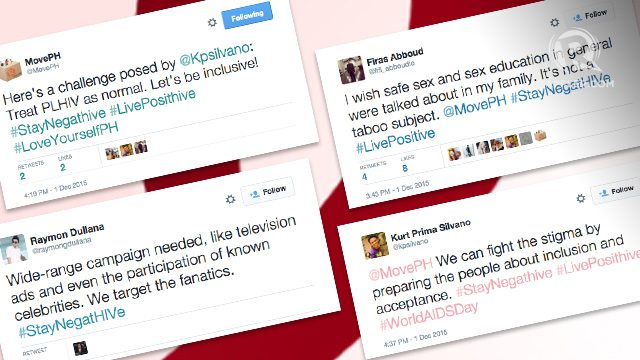SUMMARY
This is AI generated summarization, which may have errors. For context, always refer to the full article.

MANILA, Philippines – New human immunodeficiency virus (HIV) infections globally declined by 40% between 2000 and 2013 according to the final Millennium Development Goals (MDG) report released by the United Nations (UN) in July 2015.
But zooming in to Southeastern Asia, where the Philippines is located, regional trends showed that there was actually a slow decline or stagnation in the number of new infections.
Zooming in closer to the Philippines, data from the Department of Health (DOH) show that new HIV cases in the Philippines have grown by as much as 1,038% in as little time as 6 years.
At present, 21 Filipinos are reported to be infected with HIV daily.
On World AIDS Day, Tuesday, December 1, MovePH, Rappler’s civic engagement arm, held a Twitter conversation to put a spotlight on this important health issue.
Root cause
The root causes of the growing HIV epidemic in the country, netizens argued, are multi-faceted and complex.
Therefore, an holistic way to address the issue requires a two-pronged approach: curbing the rise of new infections and fighting the stigma attached to the HIV positive community.
During the conversation, MovePH tackled the possible root causes of the problem. Here’s what netizens have to say:
#StayNegatHIVe
More and more young people are acquiring the virus. What needs to be done about this?
According to Twitter users Raymon Dullana and Edgie Guevarra, the conservative culture in the Philippines forces people to shrug off the pressing issue – often tagged as taboo – under the rug. During the #StayNegatHIVe portion of the conversation, netizens added that this practice contributes to the misinformation and lack of awareness on HIV.
Given the complexity of the root causes of the HIV epidemic, netizens agreed that curbing its rise in the country requires effort from all stakeholders: government, public, and civil society.
To help strengthen information drive on the issue, here’s what netizens suggested:
#LivePositive
Beyond raising awareness on how HIV spreads, netizens said it is important to likewise address the stigma attached to people living with HIV (PLHIV).
During the #LivePositive part of the conversation, Kurt Prima Silvano of LoveYourself PH said that we can debunk stereotypes and fight discrimination against PLHIV “by preparing the people about inclusion and acceptance.”
//Why do think HIV became an epidemic in the country? How can we fight the stigma against PLHIV? Join the discussion and tell us what you think on X! – Rappler.com
HIV/AIDS is a problem in many communities – both rural and urban – across the Philippines. Responding to our communities’ concern about the issue, Rappler’s MovePH is launching a campaign to promote awareness on the issue. Follow our stories through the hashtags #StayNegatHIVe#LivePositive
Add a comment
How does this make you feel?
There are no comments yet. Add your comment to start the conversation.